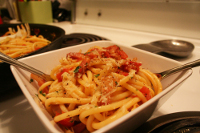 Here’s something you should always have in your fridge: pancetta.
Here’s something you should always have in your fridge: pancetta.
For the uninitiated, pancetta is a salt-cured pork belly, usually spiced with some combination involving nutmeg, chillies, garlic and pepper. Though there are several varieties, what you’re likely to find in your local grocery are either the “hot” or “sweet” varieties, either in a rolled or flat formation (the latter looks more like a small slab of bacon). I’ve never been so adventurous to actually make my own, but the stuff from the store is, like most other bacon-related products, completely worth having around. It’s as much a staple in our house as juice or eggs, and few trips to the grocery store are complete without tossing a package of this business in the cart.
I call it a staple, but pancetta deserves a more laudatory categorization, because it can pretty much take a perfunctory meal to the next level with little effort. Examples? Poach an egg over toast and brown up a few diced pieces to crumble on top. Add it to soups or stews before sautéing the vegetables. Throw it in a roasting or sauté pan with some green vegetables (especially green beans or kale, but especially Brussels sprouts). Get razor-thin slices of the round type, bake until crispy, and use it as a base for an h’or d’oeuvre. Crisp it up in a pan and crumble over your salad. Oh, you have all that rendered fat left? Use it in a warm bacon-like vinaigrette. You can do this. Because the pancetta is already in your fridge.
Despite its many uses, however, pancetta and pasta pretty much belong together, and I use it most frequently in sauces. The recipe below for my own bastardized version of Bucatini all’Amatriciana perfectly showcases the salty, fatty goodness of pancetta alongside simple and fresh ingredients: tomatoes, garlic, bright green parsley, chilis and pecorino cheese. Moreover, this dish is ridiculously quick to whip up, and mostly uses stuff you’ll already have in your pantry. The recipe traditionally uses guanciale, but I actually like the substitution of pancetta in this.
Some other notes on ingredients: I prefer using a few fresh tomatoes, but canned diced ones will also do. You can also use any long pasta (spaghetti or linguine work well) but bucatini (which is like a thicker, hollow spaghetti) is a bit more toothsome and interesting. Make sure you use a large pot with plenty of water to boil the bucatini — it can be a bit unwieldy at first when cooking down due to its thickness. Finally: as I mentioned, you can get pancetta either rolled or flat, but I find that for this recipe the flat type is easier to dice into smaller strips with even fat distribution. Store the pancetta in your fridge wrapped tightly in saran wrap for up to three weeks.
Bucatini all’Amatriciana
1 cup diced pancetta (hot or sweet — I prefer hot)
1-2 tbsp olive oil
3 cloves garlic, minced
Large pinch crushed chilis
3 ripe plum tomatoes, in a rough dice (or 1 cup diced canned tomatoes, drained)
1/2 cup dry white wine or chicken stock
1 lb bucatini
Large handful grated Pecorino Romano cheese
Large handful fresh flat-leaf parsley, chopped
Kosher salt
Fresh ground pepper
1. In a cold, large skillet, cook the diced pancetta on medium heat until fat begins to render and the edges start to brown slightly.
2. While pancetta is cooking, prep garlic, tomatoes, cheese and parsley. Put a large pot of lightly salted water on to boil.
3. Once pancetta is lightly browning, there should be a decent amount of fat in the pan depending on how fatty the cut is. Add a tbsp or so of olive oil if you think more is needed – there should be about 2 tbsp of fat/oil in total in the pan. Add garlic and chilis and stir, cooking gently for a few minutes.
4. Add tomatoes and cook for 30 seconds. Add wine and bring to a boil, then reduce to a simmer to allow alcohol to cook off.
5. Meanwhile, add pasta to boiling water and cook til just al dente (bucatini takes a little longer, usually around 11 minutes).
6. Just before the pasta is done, ladle about 1/3 cup of the pasta water into the pan and bring back up to medium heat. The starch in the water will help thicken the sauce slightly and allow it to cling to the pasta.
7. Drain pasta, then toss together with sauce, parsley, and half the cheese. Season to taste with salt and pepper, then top individual bowls with remaining cheese.
Sara Chan is an articling student at a Toronto law firm. Her favourite food group is pork. Sara’s column appears every other Tuesday here on lawandstyle.ca.

